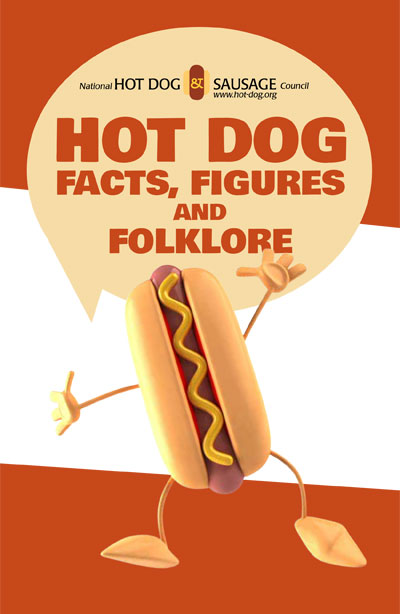Frequently Asked Questions about Hot Dogs.
The National Hot Dog and Sausage Council receives hundreds of hot dog related questions each year. While most of these questions are easy for us - the hot dog gurus - to answer, other questions are nearly impossible to answer. Below are some frequently asked questions.

Why are there typically 10 hot dogs per pack and eight buns per bag?
Ah, one of the great mysteries of the universe. You would think the makers of these two inherently linked items would collaborate on this. These days, manufacturers are starting to offer different quantities of hot dogs per pack and bakers are breaking out of the eight-to-the-pack mold and offering 10 and even 12 packs of buns. However, this is the exception to the rule.
When hot dog buns were introduced, hot dogs were sold in varying quantities at the butcher shop. Not until 1940 were hot dogs packaged the way we currently see them in the grocery store. When manufacturers began packaging hot dogs, they chose the 10 to the pack formula. Today hot dogs are sold most often in eight or ten to the pound packs, but some are sold other quantities as well.
Sandwich rolls, or hot dog buns, most often come eight to the pack because the buns are baked in clusters of four in pans designed to hold eight rolls. While baking pans now come in configurations that allow baking 10 and even 12 at a time, the eight roll pan remains the most popular.
However, to save you from the bread aisle arithmetic anxiety, you need to purchase five bags of eight-to-the-pack buns and four 10-to-the-pack hot dogs to break even.
And a specially note – while they are commonly called “hot dog buns,” they are often used to hold sausages, which come in their own unique quantities.
Why are hot dogs and baseball linked?
As the legend goes, frankfurters were dubbed the "hot dog" by a cartoonist who observed a vendor selling the "hot daschund sausages" during a baseball game at New York City's Polo Grounds. Concessionaires walked through the stands shouting "Get your red-hot dachshund sausages." In 1906, Tad Dorgan, a cartoonist for a Hearst newspaper, was inspired by the scene and sketched a cartoon with a real dachshund dog, smeared with mustard, in a bun. Supposedly, Dorgan could not spell the name of the dog, instead writing "get your hot dogs" for a caption. However, Dorgan's cartoon has never been located and some hot dog historians suggest the "dachshund" sausages were being called hot dogs on college campuses in the 1890s. "Little dog" sausages became standard fare at ballparks in 1893 when St. Louis bar owner and German immigrant Chris Von de Ahe, who owned the St. Louis Browns baseball team.
Besides its early association with baseball parks, hot dogs are easy to prepare, inexpensive and easily portable making them the perfect food to enjoy while cheering on a favorite team. Hot dogs are considered a fun summertime food, eaten most often between Memorial Day and Labor Day - coinciding with the peak of baseball season.
And while we're on the subject of street carts, just how many hot dogs are sold on the Fourth of July at street carts in New York City?
Figuring out the precise number of hot dogs sold at specific locations or on specific days is nearly impossible. Street carts don't publish sales figures and dividing hot dog sales down to days would be an exhausting job.
We do know that the southern United States eats the bulk of all hot dogs each year - more than any other region of the country. Residents of New York City purchase more hot dogs at retail outlets (grocery stores, supermarkets, etc.) than any other city in the country - over $101 billion dollars worth. And travelers passing through Chicago's O'Hare International Airport consume more hot dogs there than LaGuardia in New York and Los Angeles International.
For more detailed statistics on regional consumption of hot dogs and sausages, contactInformation Resources,Inc. or AC Nielsen.
How many hot dogs do Americans eat each year and where do they eat them?
According to recent survey data obtained by the Council, Americans purchase 350 million pounds of hot dogs at retail stores - that's 9 billion hot dogs! But the actual number of hot dogs consumed by Americans is probably much larger. It is difficult to calculate the number of hot dogs Americans may eat at sporting events, local picnics and carnivals. The Council estimates Americans consume 20 billion hot dogs a year - more than twice the retail sales figures. That works out to about 70 hot dogs per person each year. Hot dogs are served in 95 percent of homes in the United States. Fifteen percent of hot dogs are purchased from street vendors and 9 percent are purchased at ballparks, according to statistics from the Heartland Buffalo Company.
What exactly is in a hot dog?
The ingredients in hot dogs have been the subject of much humor, rumor and speculation. But the answer is less exciting than the question.
All hot dogs are cured and cooked sausages that consist of mainly pork, beef, chicken and turkey or a combination of meat and poultry. Meats used in hot dogs come from the muscle of the animal and looks much like what you buy in the grocer's case. Other ingredients include water, curing agents and spices, such as garlic, salt, sugar, ground mustard, nutmeg, coriander and white pepper.
If variety meats such as liver and hearts are used in processed meats, the U.S. Department of Agriculture requires the manufacturer to declare those ingredients on the package with the statement "with variety meats" or "with meat by-products." The manufacturer must then specify which variety meat is included. In the U.S., companies are required to list ingredients in order, from the main ingredient, to the least ingredient.

